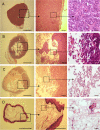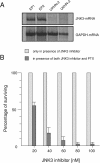Head and neck cancer cells and xenografts are very sensitive to palytoxin: decrease of c-jun n-terminale kinase-3 expression enhances palytoxin toxicity
- PMID: 23409748
- PMCID: PMC3585753
- DOI: 10.1186/1476-4598-12-12
Head and neck cancer cells and xenografts are very sensitive to palytoxin: decrease of c-jun n-terminale kinase-3 expression enhances palytoxin toxicity
Abstract
Objectives: Palytoxin (PTX), a marine toxin isolated from the Cnidaria (zooanthid) Palythoa caribaeorum is one of the most potent non-protein substances known. It is a very complex molecule that presents both lipophilic and hydrophilic areas. The effect of PTX was investigated in a series of experiments conducted in head and neck squamous cell carcinoma (HNSCC) cell lines and xenografts.
Materials and methods: Cell viability, and gene expression of the sodium/potassium-transporting ATPase subumit alpha1 (ATP1AL1) and GAPDH were analyzed in HNSCC cells and normal epithelial cells after treatment with PTX using cytotoxicity-, clonogenic-, and enzyme inhibitor assays as well as RT-PCR and Northern Blotting. For xenograft experiments severe combined immunodeficient (SCID) mice were used to analyze tumor regression. The data were statistically analyzed using One-Way Annova (SPSS vs20).
Results: Significant toxic effects were observed in tumor cells treated with PTX (LD50 of 1.5 to 3.5 ng/ml) in contrast to normal cells. In tumor cells PTX affected both the release of LDH and the expression of the sodium/potassium-transporting ATPase subunit alpha1 gene suggesting loss of cellular integrity, primarily of the plasma membrane. Furthermore, strong repression of the c-Jun N-terminal kinase 3 (JNK3) mRNA expression was found in carcinoma cells which correlated with enhanced toxicity of PTX suggesting an essential role of the mitogen activated protein kinase (MAPK)/JNK signalling cascades pathway in the mechanisms of HNSCC cell resistance to PTX. In mice inoculated with carcinoma cells, injections of PTX into the xenografted tumors resulted within 24 days in extensive tumor destruction in 75% of the treated animals (LD50 of 68 ng/kg to 83 ng/kg) while no tumor regression occurred in control animals.
Conclusions: These results clearly provide evidence that PTX possesses preferential toxicity for head and neck carcinoma cells and therefore it is worth further studying its impact which may extend our knowledge of the biology of head and neck cancer.
Figures





Similar articles
-
Mutations of the LIM protein AJUBA mediate sensitivity of head and neck squamous cell carcinoma to treatment with cell-cycle inhibitors.Cancer Lett. 2017 Apr 28;392:71-82. doi: 10.1016/j.canlet.2017.01.024. Epub 2017 Jan 23. Cancer Lett. 2017. PMID: 28126323 Free PMC article.
-
Lysyl oxidase like-4 monoclonal antibody demonstrates therapeutic effect against head and neck squamous cell carcinoma cells and xenografts.Int J Cancer. 2016 May 15;138(10):2529-38. doi: 10.1002/ijc.29986. Epub 2016 Jan 25. Int J Cancer. 2016. PMID: 26756583
-
Elevated RET expression enhances EGFR activation and mediates EGFR inhibitor resistance in head and neck squamous cell carcinoma.Cancer Lett. 2016 Jul 10;377(1):1-10. doi: 10.1016/j.canlet.2016.04.023. Epub 2016 Apr 18. Cancer Lett. 2016. PMID: 27090738
-
Crizotinib Fails to Enhance the Effect of Radiation in Head and Neck Squamous Cell Carcinoma Xenografts.Anticancer Res. 2015 Nov;35(11):5973-82. Anticancer Res. 2015. PMID: 26504020
-
Modulation of protein kinase signaling cascades by palytoxin.Toxicon. 2011 Mar 1;57(3):440-8. doi: 10.1016/j.toxicon.2010.11.003. Epub 2010 Nov 9. Toxicon. 2011. PMID: 21070801 Free PMC article. Review.
Cited by
-
Inhibition of Prolactin Affects Epididymal Morphology by Decreasing the Secretion of Estradiol in Cashmere Bucks.Animals (Basel). 2024 Jun 13;14(12):1778. doi: 10.3390/ani14121778. Animals (Basel). 2024. PMID: 38929397 Free PMC article.
-
Proteomic Studies of the Mechanism of Cytotoxicity, Induced by Palytoxin on HaCaT Cells.Toxins (Basel). 2022 Apr 10;14(4):269. doi: 10.3390/toxins14040269. Toxins (Basel). 2022. PMID: 35448878 Free PMC article.
-
Industrial Applications of Dinoflagellate Phycotoxins Based on Their Modes of Action: A Review.Toxins (Basel). 2020 Dec 18;12(12):805. doi: 10.3390/toxins12120805. Toxins (Basel). 2020. PMID: 33353166 Free PMC article. Review.
-
Ancient Venom Systems: A Review on Cnidaria Toxins.Toxins (Basel). 2015 Jun 18;7(6):2251-71. doi: 10.3390/toxins7062251. Toxins (Basel). 2015. PMID: 26094698 Free PMC article. Review.
-
A Focal Adhesion-Related Gene Signature Predicts Prognosis in Glioma and Correlates With Radiation Response and Immune Microenvironment.Front Oncol. 2021 Sep 22;11:698278. doi: 10.3389/fonc.2021.698278. eCollection 2021. Front Oncol. 2021. PMID: 34631528 Free PMC article.
References
-
- Kan Y, Uemura D, Hirata Y, Ishiguro M, Iwashita T. Complete NMR signal assignment of palytoxin and N-acetylpalytoxin. Tetrahedron Let. 2001;42(18):3197–3202. doi: 10.1016/S0040-4039(01)00407-5. - DOI
-
- Bignami GS, Senter PD, Grothaus PG, Fischer KJ, Humphreys T, Wallace PM. N-(4’-hydroxyphenylacetyl)palytoxin: a palytoxin prodrug that can be activated by a monoclonal antibody-penicillin g amidase conjugat. Cancer Res. 1992;52(20):5759–5764. - PubMed
Publication types
MeSH terms
Substances
LinkOut - more resources
Full Text Sources
Other Literature Sources
Medical
Research Materials
Miscellaneous

